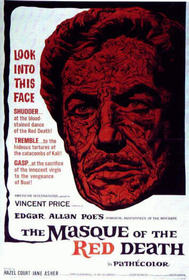Our editor-in-chief Nate Yapp is proud to have contributed to the new book Hidden Horror: A Celebration of 101 Underrated and Overlooked Fright Flicks, edited by Aaron Christensen. Another contributors include Anthony Timpone, B.J. Colangelo, Dave Alexander, Classic-Horror.com's own Robert C. Ring and John W. Bowen. Pick up a copy today from Amazon.com!
The Masque of the Red Death (1964)
In the 1960s, Roger Corman directed a series of films based on the works of American Gothic author Edgar Allan Poe. While not always accurate to the source material, the Poe Cycle has come to represent the pinnacle of Corman's directorial career, and, of these films, The Masque of the Red Death is the piece de resistance. The most faithful of the Poe adaptations, Masque uses a combination of scenery and characters to explore the darker themes originally put forth by Poe himself.
While the countryside is being ravaged by a terrible plague, The Red Death, Prince Prospero (Vincent Price) and his esteemed guests are safe behind castle walls. Joining them is Francesca (Jane Asher), a virtuous village girl held against her will for Prospero's sadistic amusements. Oblivious to the suffering outside the castle, the celebrants revel in their debauchery and debasement, unaware that Death is lurking in their midst.
With a budget of two-hundred thousand dollars and a full five weeks dedicated to production (two weeks longer than any previous Corman film), Masque is one of the most lavish and visually stunning films of the Poe Cycle. With a plethora of atmospheric shots and vivid color, Masque creates a jarring visual divide between how people and places appear and how they behave. Early in the film, when Prospero is introducing Francesca to the court, the camera pans out onto a breathtaking scene of the great hall and its guests. The sense of extravagant gentility and finery the scene creates is quickly dissipated when Prospero begins instructing his guests to act as animals, making the beautiful bawdy. This type of hedonistic social orgy, which converts the cultured courtesan into a lowly beast, proves to be the hallmark of Prospero's festivities throughout the film and highlights his inhumanity. This juxtaposition between natural and unnatural is only the first of many such pairings. It is again apparent during Francesca's journey through the series of four colored rooms, which alternate between vividly bright and dark colors. This alternation between light and dark settings is a visual representation of the struggle between Francesca's purity and Prospero's corruption, a dichotomy that figures prominently throughout the film.
The characters also mirror this divide between good and evil and are, in particular, dependent on Corman's portrayal of his female protagonist. Rather than the simpering, frail maiden characteristic of most previous Gothic films, Corman creates in Francesca a surprisingly assertive adversary to Prospero's evil. Embodying “modesty, but not humility,” this initiative first catches Prospero's eye when Francesca fearlessly pleads for the life of her friends. Much like one of his falcons, Prospero sees her as a willful creature to be broken. Francesca, however, possesses both faith and integrity, and uses them to continually defy Prospero. It is only to save the life of her lover, an act of calculated sacrifice, that Francesca gives up these virtues, finally falling into the stereotypical genre role. However, as an act of choice, Francesca's eventual submission is anything but weak, and her actions mark her as a strong character and a worthy opponent to the sinister Prospero.
As the characterizations and setting both imply, Masque is a film of dichotomy – Francesca versus Prospero, virtue versus sin, good versus evil. These dichotomies, however, are only skillfully created smoke and mirrors, meant to distract and misdirect the viewer from the true theme of the film. These designations, seemingly so important, are ultimately insignificant. After culling the village, the Red Death infiltrates Prospero's masquerade, taking the lives of those supposedly protected within the castle walls. By the end of the film, both “good” and “evil” are destroyed by the plague. As the Red Death reveals to his companions, only six arbitrary survivors remain. Death cares not whether its victims are worthy or wicked, young or old, beautiful or homely. As Masque of the Red Death so elegantly illustrates, everyone is equal in death.
While often embellishing on the original story, The Masque of the Red Death remains true to the essence of Poe's work. The settings, characters and dark themes all combine to create a Gothic, surrealistic world suitable to the Red Death's machinations, and, of course, the pervading sense of horror and foreboding characteristic of a Gothic film. It is therefore unsurprising that The Masque of the Red Death is considered one of Roger Corman's greatest directorial accomplishments and the high point of the Poe Cycle. It is a brilliant film, both visually and thematically, and one that every classic horror fan would do well to watch.
Trivia:
Shot in England to take advantage of a British production subsidy.









Thanks I enjoyed your review,
Thanks I enjoyed your review, that was absolutely one of Vincent Price's more fun films. I mean he's made many, but this one's a true treasure. Maybe sometime you can review a lesser talked about film, the Witchfinder General. I'd be interested in your perspective on that. The movie's also called Conqueror Worm but I'm not sure if either's a different version for length/content etc.
Thanks.
We do have a Witchfinder
We do have a Witchfinder General review, albeit by a different writer.
"He went for a little walk! You should have seen his face!"